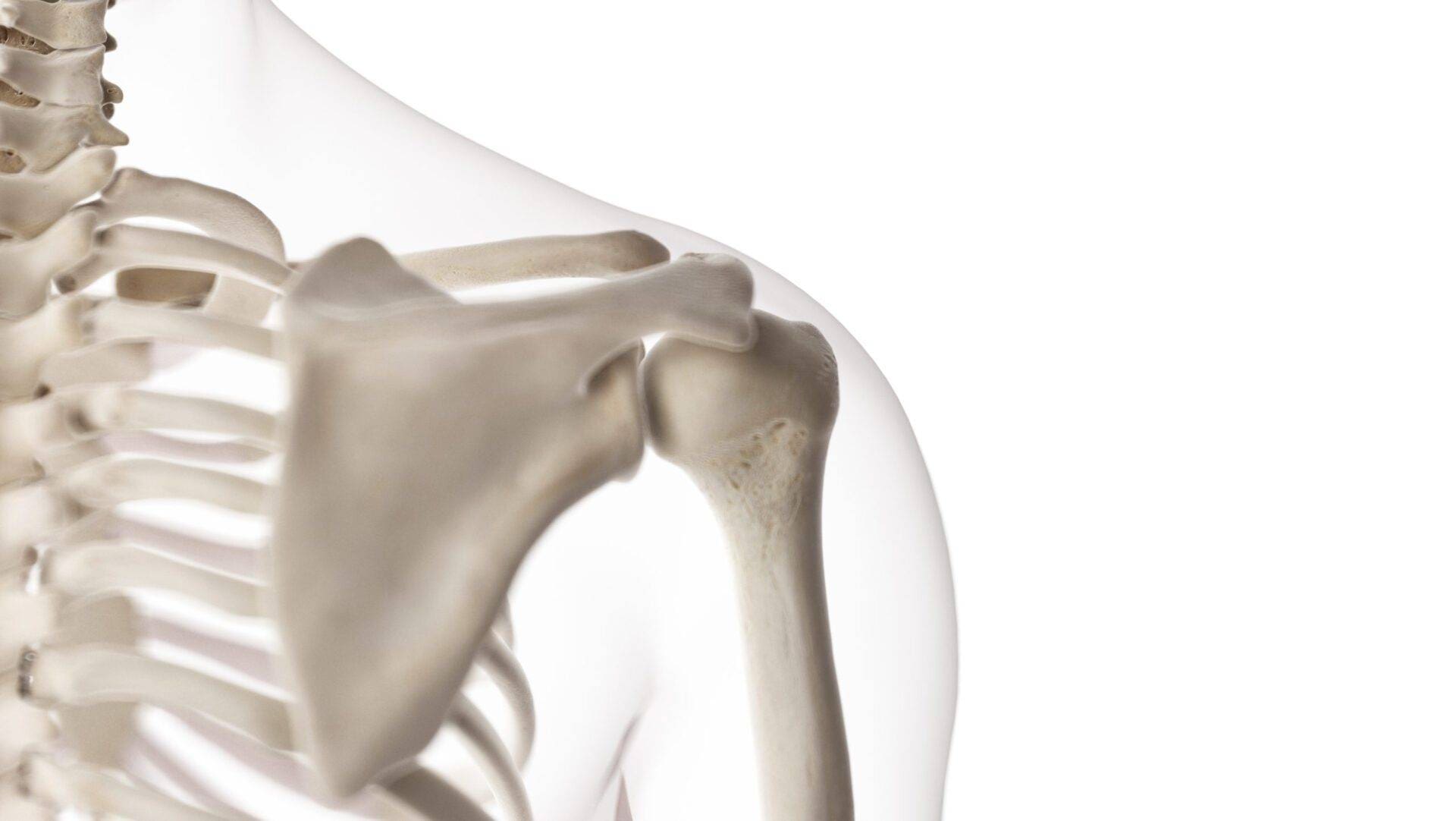By Dr. Richard Thompson, DC
7 Minute Read

Firstly, it’s important to understand a few key definitions that pertain to this article. Chronic refers to the duration of the problem having been ongoing for three months or longer. This often inaccurately refers to how long the symptoms have been around since most of us don’t realize there’s a problem developing until we start to feel it. But in most chronic cases, there is a buildup of tissue and/or joint dysfunction that has led to the development of symptoms. It’s also important to understand the difference between the shoulder joint and the shoulder girdle. Your shoulder joint is the ball-in-socket joint formed by the upper arm (humerus) and the outer part of your shoulder blade. This joint is known as the glenohumeral joint. I often see patients point to their upper back when referring to shoulder pain. This is actually the shoulder blade, which sits over the top of the rib cage and makes up one of three joints of the shoulder girdle. When pain is truly related to the shoulder joint, the pain is evident in front, on top, or behind the ball-in-socket or upper arm in the vast majority of cases.
So why are shoulder injuries often difficult to overcome? Let’s look at three major factors that contribute to the challenge of recovering from shoulder pain.

The Shoulder Joint is Complex & Unique
The shoulder joint has the greatest amount of range of motion of any joint in the human body. When you think about how much motion you can create in your shoulder compared to your hip, knee, or elbow, the freedom of motion is no comparison. But in order to achieve this massive range of motion comes with sacrifice – joint stability. The typical ball-in-socket joint in the body has a ball (the rounded head of a bone inserted into the joint) and a socket, or the cup, that houses the ball to create an articulation. For the shoulder, the ball (head of the humerus) is shaped similarly to any other ball joint. However, the socket (outer part of the shoulder blade) is extremely shallow, which allows the ball to rotate freely against the socket. In order to provide stability to the joint, the socket is lined with a labrum, or cartilage that helps the ball articulate with the socket more congruently. But the most unique, and possibly most complex feature of the shoulder joint is the function of the rotator cuff, which are four muscles/tendons that help provide movement at the shoulder joint, but also provide coordinated activity to stabilize the ball against the socket. This rotator cuff is a critical component of the shoulder joint integrity and when compromised, will lead to joint mobility problems, pain, and inflammation.

We Rarely Give The Shoulder A Break
You may not realize it, but almost every movement we induce on a regular basis to perform our activities of daily living involves movement at the shoulder joint. Whether it’s brushing your teeth, tying your shoelaces, or driving your car, the shoulder joint is required to provide functional movement and coordination. But probably the most common form of prolonged stress imposed on the shoulder joint, particularly when you’re dealing with an injury, is from the position you sleep in. When I assess a patient with a chronic shoulder injury, the patient is often exhausted because they are unable to find a comfortable position to sleep in. Even if they are able to find a comfortable position, it’s only a matter of minutes before they turn over in their sleep and the pain quickly wakes them up. Unfortunately for patients in this situation, a lack of restorative sleep only complicates the injury recovery process, and the body struggles to heal when it’s deprived of the regular rest it requires.
Another reason why we often don’t give the shoulder a break when dealing with an injury is because, with many types of shoulder injuries, pain is completely absent until you move the shoulder in a particular manner. Because pain isn’t constant, we forget that there’s a problem and we lack that reminder to be careful with what we do with that shoulder. So by the time you’ve tried to reach behind you, lift the grocery bag, or catch the falling coffee cup, the reaggravation of pain (and tissue irritation) has already occurred. This often causes a set-back in tissue healing, whether or not your are actively treating the shoulder problem.

We Don’t Pay Attention to Spinal Posture
One of the most common reasons for low-grade, gradual onset shoulder pain is the lack of proper posture in the neck and upper back. As you can imagine, poor posture in the upper spine can often lead to neck pain, headaches, and upper back pain and tension. What’s not obvious are the consequences of poor upper body posture on the shoulder blade and ultimately the shoulder joint. When you look at the anatomy of the shoulder blade that sits on the rib cage, the shape of the rib cage is essential for the normal movement of the shoulder blade, known as scapulothoracic kinesis. This is considered one of the three joints that make up the shoulder girdle, and shoulder blade mobility has a direct impact on how the shoulder joint can move. Take a second and visualize the following scenario: you’re sitting at your laptop computer, having a hard time seeing the screen, and the desktop is lower than it should be. Your neck flexes forward, your upper back collapses, and your head extends at the upper neck. When the upper thoracic spine collapses into excessive flexion, known as hyperkyphosis, the shape of the ribcage also changes. The angles of the muscles supporting the shoulder blade also change, leading to decreased movement and a change in the socket position at the shoulder joint. Now, when the shoulder blade is not providing the movement it should be contributing and you need to perform an activity with your arm, the body uses the shoulder joint excessively and with abnormal movement patterns to achieve the movement. Eventually, repeated use of the shoulder joint in this unnatural position leads to repetitive, slow-onset injuries such as rotator cuff tendonitis, subacromial bursitis, or joint capsulitis, to name a few. In this case, the shoulder joint is the pain-causing structure but ultimately the root cause of the problem is the spinal posture and shoulder blade mobility.

So What Can I Do To Prevent or Recover From Shoulder Injuries Quickly?
Now that you have a better understanding of the shoulder joint and factors that lead to injury, let’s look at some relatively simple steps you can take to maintain your shoulder joint health as well as measures to take to help you recover from injury quickly:
- Build better posture: With the countless hours we spend on our phones and computers, it’s inevitable that our posture will suffer. Posture is not a quick fix, so don’t fall for gimmicky tools that help ‘correct’ your posture. Posture can only be corrected by activating the muscles that support your head, neck, back, and shoulder blade. A postural strengthening routine should begin about 3 times per week in combination with stretches for tight muscles. Eventually, you can get away with doing the routine only once a week. Taking breaks from electronics use and optimizing your workspace ergonomics are also critical. For further resources on upper body posture, research Upper Crossed Syndrome from a reputable source.
- Find a supportive (not compressive) sleeping position: Finding a position that does not put pressure on the joint can be difficult, but not necessarily impossible. When dealing with a shoulder injury, try to find a sleeping position that does not irritate the shoulder by ideally sleeping on your back with the neck properly supported with your pillow. If sleeping on your back is not possible (when your spouse has an issue with your snoring), try sleeping on the side of your healthy shoulder with your arm on the injured side resting on a thick pillow in front of you. Possibly the worst position to sleep in would be on your stomach with your arms under your pillow. Not only would it be impossible to not induce further stress to an existing shoulder injury, but this position can often lead to impingement-type injuries in healthy shoulders.
- Focus on inflammation control and healing before functional rehabilitation: Far too often I meet with patients dealing with chronic shoulder injuries who have been working on rehabilitative exercises for the shoulder before the injury has been provided enough opportunity to at least begin healing. When a shoulder injury occurs, whether from a quick mechanism such as a fall on the arm or from repetitive dysfunction as described above, the tissues (tendons, bursa, joint capsule, etc.) around the joint become inflamed. Before trying to correct your movement pattern or strengthen the structures supporting the joint, it’s critical to reduce and eliminate the inflammation so that healing can occur. This can be through the use of cryotherapy (icing) or anti-inflammatories such as topical cream or oral non-steroidal anti-inflammatory. Once the healing has reached a certain level, then rehab protocols should be commenced.
Although the shoulder joint is a complex piece of anatomy and injuries can often become difficult to overcome, you can take solace in knowing that with a proper diagnosis and systematic approach to treating the injury, you can eliminate the pain sooner rather than later. If you have struggled with a nagging, ongoing shoulder injury, feel free to reach out to our team of experienced healthcare providers to assess the problem and get you back on your road to a quick recovery!

